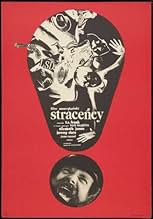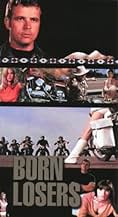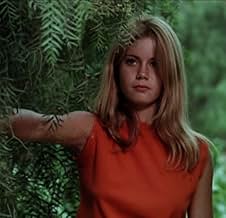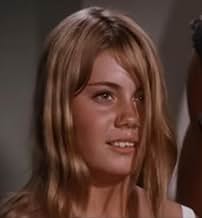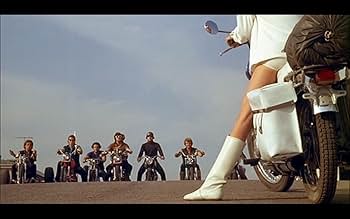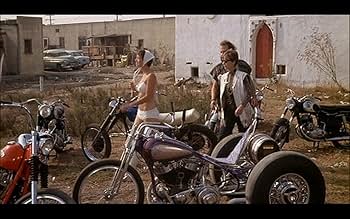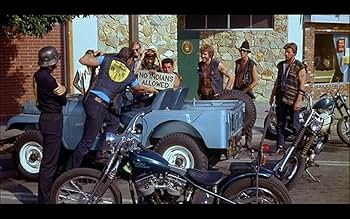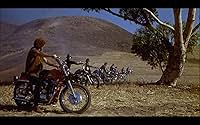Ajouter une intrigue dans votre langueBilly Jack battles a motorcycle gang in a small California beach town.Billy Jack battles a motorcycle gang in a small California beach town.Billy Jack battles a motorcycle gang in a small California beach town.
- Réalisation
- Scénario
- Casting principal
Robert Tessier
- Cueball
- (as Robert W. Tessier)
Stuart Lancaster
- Sheriff Harvey
- (as Stewart Lancaster)
Avis à la une
Loner Billy Jack (Tom Laughlin), just returned from Viet Nam, pits himself against a vicious motorcycle gang who are terrorizing a California town, protecting a rape victim and standing alone when even the police are reluctant to act.
This is one of the best of its kind. Made on a shoestring budget the tight storyline allows for few frills but plenty of classic hero and villain tension. In-your-face violence for its time, only a little martial-arts action (compared to the later BJ films) but all the ingredients are on hand for a character who is destined to become an American screen icon.
The nattering nabobs can kavetch about bad acting until their faces turn blue---Billy Jack is what he is, and Laughlin plays him to perfection. Particular credit goes to veteran actor Jeremy Slate as the complicated, arrogant gang leader, and again to Laughlin, for writing the part. Laughlin's villains have an element of sympathy. They may be monsters, but they have reasons for the way they behave and this makes them more human.
Look for an early walk-on by Laughlin's wife and later screen partner Delores Taylor (also his executive producer and co-writer)and their son and daughter (she would have a substantial role in following BJ flicks).
Also on hand is one of our favorite heavies, Robert Tessier as CueBall, sporting thick dark hair before he adopted his well-known shaved-head look. Tessier, a military vet and stunt man, was also the stunt adviser for the film.
Classic hero defending his girl against despicable bad guys makes for ONE TERRIFIC MOVIE. If you like this one check out BILLY JACK and DEFIANCE (Jan-Michael Vincent).
This is one of the best of its kind. Made on a shoestring budget the tight storyline allows for few frills but plenty of classic hero and villain tension. In-your-face violence for its time, only a little martial-arts action (compared to the later BJ films) but all the ingredients are on hand for a character who is destined to become an American screen icon.
The nattering nabobs can kavetch about bad acting until their faces turn blue---Billy Jack is what he is, and Laughlin plays him to perfection. Particular credit goes to veteran actor Jeremy Slate as the complicated, arrogant gang leader, and again to Laughlin, for writing the part. Laughlin's villains have an element of sympathy. They may be monsters, but they have reasons for the way they behave and this makes them more human.
Look for an early walk-on by Laughlin's wife and later screen partner Delores Taylor (also his executive producer and co-writer)and their son and daughter (she would have a substantial role in following BJ flicks).
Also on hand is one of our favorite heavies, Robert Tessier as CueBall, sporting thick dark hair before he adopted his well-known shaved-head look. Tessier, a military vet and stunt man, was also the stunt adviser for the film.
Classic hero defending his girl against despicable bad guys makes for ONE TERRIFIC MOVIE. If you like this one check out BILLY JACK and DEFIANCE (Jan-Michael Vincent).
Contrary to one reviewer's information, "Born Losers" was a smash at the box office the FIRST time it was released in '67. And it's easy to see why. It's the most entertaining of the "biker movie" genre, because it has a story and vivid characters. Elizabeth James is Vicky Barrington, a vacationing college student who comes up against a nasty motorcycle gang in a California mountain town. Naturally, the gang, headed by a weathered Jeremy Slate, take off after Vicky (who is on a motorcycle wearing white boots and a matching bikini) and two of them eventually catch and rape her. She's not the only victim. Three incredibly foolish local girls visit the gang's "clubhouse" and meet a similar fate. But they don't have a champion like Tom Laughlin (in his first appearance as Billy Jack) who manages to get Vicky out of danger (at least for a while) and subsequently falls in love with her. "Born Losers" has a great score by "Wild Angels" composer (and future Lieutenant Governor of California) Mike Curb, good acting by a large cast, and a fine cameo appearance by Jane Russell as the trashy mother of one of the victimized girls. Add some beautiful locations and some slick motorcycle stunts, and you have a "Born Winner!" Incidentally, beautiful Ms. James turned up as a police dispatcher in the seventies cult classic, "Dirty Mary Crazy Larry". She also wrote the screenplay for "Born Losers" (under the pen name 'E. James Lloyd').
The first "Billy Jack" film is a serious examination of rape and personal cowardice disguised as a biker/drug exploitation film. It manages to satisfy on both counts. No nudity, lots of outrageous clothing, and plenty of nazi bikers. Not quite as good as its sequel (which was written previously) but also not so preachy and talky. Dig the "nature carnage" at the film's beginning. Decent photography (marred in the DVD presentation by pan and scan process), but mid to low grade actors. Russell appears as a burnt-out, harried mom. Is she really acting? She's way over the top, but fun as always.
p.s. (2008, second viewing) p.s. the movie isn't going to appeal to everyone, but it's coming from a good place compared to a lot of exploitation films. There's a lot of classic Hollywood here, Tom Laughlin drawing on a lot of his roots. Like "Billy Jack" this movie is a very passionate statement against rape and it condemns society's attitude about rape. But because the victims are so beautiful, frankly the movie feels more exploitative and less serious than the more successful sequel. You could look on this movie as a learning experience for Laughlin, but it's a very interesting drive-in biker movie in and of itself, very different and more carefully put together than a lot of its brethren. For example this time around I noticed that the film can be seen as an anti-Western -- as opposed to the stereotypical concept of a white man rescuing the white virgins from the "indians", here we have an ostensibly Native American hero rescuing the white women from white bikers (bikes and jeeps standing in for horses and stagecoaches in the traditional Western iconography of course).
p.s. (2008, second viewing) p.s. the movie isn't going to appeal to everyone, but it's coming from a good place compared to a lot of exploitation films. There's a lot of classic Hollywood here, Tom Laughlin drawing on a lot of his roots. Like "Billy Jack" this movie is a very passionate statement against rape and it condemns society's attitude about rape. But because the victims are so beautiful, frankly the movie feels more exploitative and less serious than the more successful sequel. You could look on this movie as a learning experience for Laughlin, but it's a very interesting drive-in biker movie in and of itself, very different and more carefully put together than a lot of its brethren. For example this time around I noticed that the film can be seen as an anti-Western -- as opposed to the stereotypical concept of a white man rescuing the white virgins from the "indians", here we have an ostensibly Native American hero rescuing the white women from white bikers (bikes and jeeps standing in for horses and stagecoaches in the traditional Western iconography of course).
This movie is interesting on many levels. Although it contains a few shocking scenes (if viewed unedited) it still comes across as kind of campy. When a girl on a motorcycle p***es off a motorcycle gang the fun begins. First of all, the girl on the cute little scooter type motorcyle looks like she just finished a gig on the "Hullabaloo" TV show complete with her matching go-go boots and bikini. She is kinda cute except she has a haircut that looks like they put a bowl on her head and cut around it. (She could have at least wore a "Bob's Big Boy Cascade" to sex it up a bit). She mouths off to the group of scumbags who all look like rejects from the Manson Family.
One shocking scene for 1967 is the part where two gang members french kiss (they are both men)! This is to illustrate the free-sex attitude of the era and supposedly (I am guessing here) to show what a bunch of degenerates these guys are.
Jane Russell is over the top here as a drunken, floozy mother of a teenage trollop who does a strip tease in her trailer park that has to be seen to be believed. The look on her face while stripping is somewhere between orgasmic and root canal. RENT THIS AND HAVE FUN!
One shocking scene for 1967 is the part where two gang members french kiss (they are both men)! This is to illustrate the free-sex attitude of the era and supposedly (I am guessing here) to show what a bunch of degenerates these guys are.
Jane Russell is over the top here as a drunken, floozy mother of a teenage trollop who does a strip tease in her trailer park that has to be seen to be believed. The look on her face while stripping is somewhere between orgasmic and root canal. RENT THIS AND HAVE FUN!
While the acting and plot were weak, this movie is worth watching, if only to educate or remind us of the tumultuous 60s... with the ending of the Vietnam War, Hells Angels, drugs-sex-and-rock-n-roll... in a society where returning Vietnam Vets were considered renegades and loose cannons or just plain crazy... in a society where we screamed peace, while resorting to violence... in a society where women's lib was just beginning to surface in the American Consciousness, with the burning of the bras... in a society where the youth of our country cried out against the "establishment", and we "did our own thing"... where altruism flourished along with the rise in cults, crusading preachers, and activism... in a time when man first walked on the moon... when we, as a society believed... nothing at all could stop us. In all, the movie depicted well the general atmosphere of beliefs and attitudes of the times, that, while they might seem moronic to us in today's world, perhaps, 30 years in the future, our attitudes and beliefs will seem moronic to the generations to follow.
Le saviez-vous
- AnecdotesBased on a real incident in 1964 when members of the Hell's Angels motorcycle gang were arrested for raping five girls in Monterey, California.
- GaffesAt the beginning of the scene at the Shorns' house, the LP record Jodell is looking at while talking to her mother changes from David Rose's 'The Stripper' into 'Music to Strip By' and then back again. These were both actual stripper-themed LPs released in the 1960s (perhaps suggesting Mrs. Shorn's previous occupation?)
- Citations
Vicky Barrington: Oh--Why do you call him "Crabs"?
Daniel 'Danny' Carmody: 'Cause he's got 'em. Ever since he caught the disease from some broad he's been crawlin' with 'em. He's okay, though, he's a good cat.
Vicky Barrington: Oh, I'm sure.
- ConnexionsFeatured in Dusk to Dawn Drive-In Trash-o-Rama Show Vol. 2 (1996)
- Bandes originalesBilly Jack's Theme
Written and Produced by Mike Curb
Co-produced by Al Simms
Performed by Davie Allan with The Arrows (as The Sidewalk Sounds)
Meilleurs choix
Connectez-vous pour évaluer et suivre la liste de favoris afin de recevoir des recommandations personnalisées
Détails
- Date de sortie
- Pays d’origine
- Langue
- Aussi connu sous le nom de
- Nacidos para perder
- Lieux de tournage
- Main Street, Seal Beach, Californie, États-Unis(Biker rally: Irisher [121], Condo's Rock Shop [125], Raines Radio [127], etc.)
- Sociétés de production
- Voir plus de crédits d'entreprise sur IMDbPro
Box-office
- Budget
- 360 000 $US (estimé)
Contribuer à cette page
Suggérer une modification ou ajouter du contenu manquant

Lacune principale
By what name was Le Credo de la violence (1967) officially released in India in English?
Répondre


